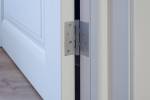New inlay procedure found to help restore up-close vision

The newest innovation to hit ophthalmology is something that photographers have known for a long time: Decreasing the aperture (opening) of the lens creates a deeper depth of field. So it’s fitting that the new method for helping people see a better variety of distances was named Kamra.
“The FDA just approved it in mid-April, so the company is just now rolling it out across the country,” said Dr. Eva Liang, ophthalmologist at Center For Sight. “The first to get it will be those in the places where there were clinical trials. Since we weren’t involved in the clinical trails, we’ll be in their second phase rollout, which will probably happen in July or August.”
The Kamra procedure is a viable answer to correcting presbyopia, which is a part of the normal aging process that reduces the ability of the eye to focus on near objects. It often becomes a factor beginning in one’s 40s. It gets worse with age.
Liang, who has enhanced the sight of more than 20,000 patients between her practice and her foundation, Sight for Life, is among the first surgeons in the U.S. to be certified to place the Kamra corneal inlay. Most of her patients suffer from cataracts, followed by Lasik patients.
“There’s a gap between people who need cataract surgery and Lasik,” she said. “Those are the people Kamra is going to fit perfectly. Before this, we really haven’t had a great surgical solution for those people between 45 and 60. … Kamra is now that solution.”
For Lasik patients, some people opt to have one eye for reading, the other for distance, called mono vision. The brain automatically switches between the two eyes depending on where one focuses. With mono vision, depth perception is sacrificed.
The Kamra procedure is implanted in only one eye. Clinical tests showed putting it in both didn’t give the patient any more reading ability, and there were issues with distance contrast and night vision.
The corneal inlay is thin at six microns thick, the thickness of a red blood cell and one-tenth the thickness of a sheet of paper. In contrast, the normal cornea is 550 microns thick. Even at that thickness, the inlay is stippled with more than 8,000 microscopic openings to allow oxygen and nutrients to get to the eye.
Nearly 20,000 people around the world have gotten the Kamra inlay, according to Dr. Minoru Tomita, executive medical director of the Shinagawa LASIK Center in Tokyo, where approximately 15,000 of those surgeries were performed.
Jack Abrams of Abrams Eye Institute said presbyopia “touches 2 billion people worldwide — about 130 million in the U.S., so you have many people who are potentially good candidates for it.”
Abrams said he looked into the procedure, talking with some of the researchers.
“The more I investigated it, personally, the more viable it seemed to be,” he said.
He said one’s eyes had to be of a certain prescription to be a candidate and that, if they weren’t, then Lasik could bring them to that point where they could have the Kamra lens inlaid.
Kamra restores clarity at near and intermediate vision, the latter being computer monitor distance. It also maintains distance vision.
Dr. Christopher DePalo, an ophthalmologist, is keen on getting it done to his eyes.
“I’m the kind of guy who goes to a restaurant and goes, ‘You know, I can’t really see the menu anymore,’ so I break out my phone and turn on the flashlight, so I’m getting there,” he said. “I’m looking forward to the potential of maintaining the type of vision I’ve always had, and it’ll keep me free from wearing glasses.”
“What’s great about Kamra is that distance is not compromised,” Liang said. “Another exciting factor: Lasik cannot be reversed; cataract (surgery) cannot be reversed — but the Kamra inlay can be removed.”
Doctors do not need to go back to school to insert a Kamra inlay; it follows standard procedures and techniques. A specific laser creates pockets in the cornea, and the inlay is inserted into the pocket.
“It’s not a huge thing to learn, but what’s very important is being very meticulous,” Liang said. “Placement is very important.”
The Kamra inlay is placed in only one eye for seeing up close. The other eye is either left untouched or is corrected for greater distance vision. Working together, the eyes allow you to see near, far and everything in-between.
Kamra is considered a long-lasting solution to presbyopia. Assuming your eyes don’t change, the inlay’s effect will be unchanged.
As with any surgery, it comes with risks, so talk to your doctor. The cost runs about $4,000.
Expect the procedure to take less than 10 minutes. Follow-up care includes eye drops.
“It’s a fantastic technology, a nice alternative … It’s a huge breakthrough because there are so many people that want to get out of (depending on) glasses,” DePalo said.
To reach Summerlin Area View reporter Jan Hogan, email jhogan@viewnews.com or call 702-387-2949.


















